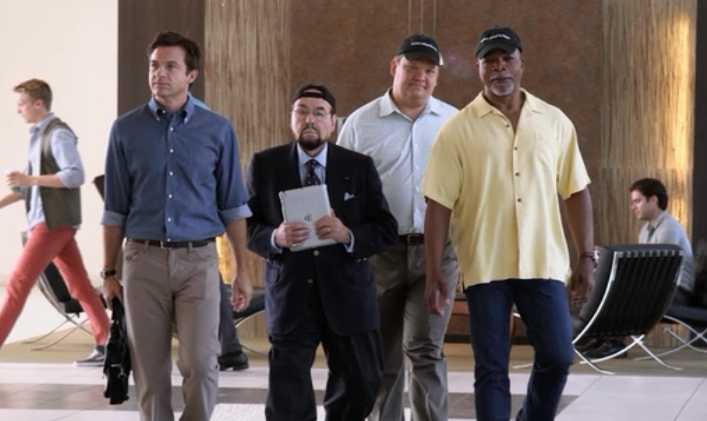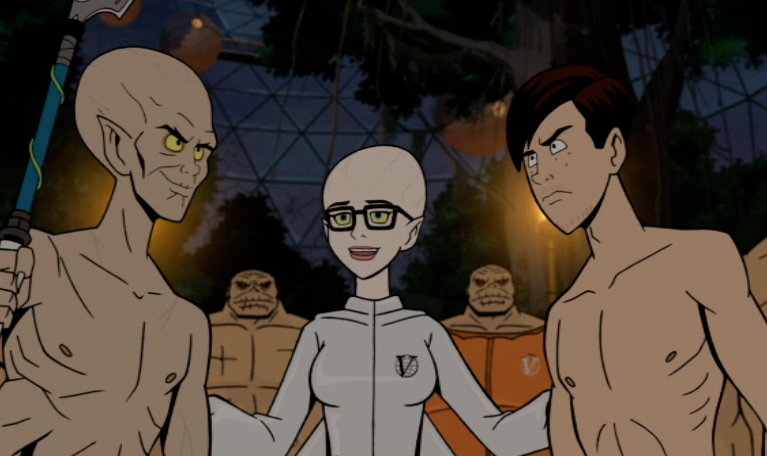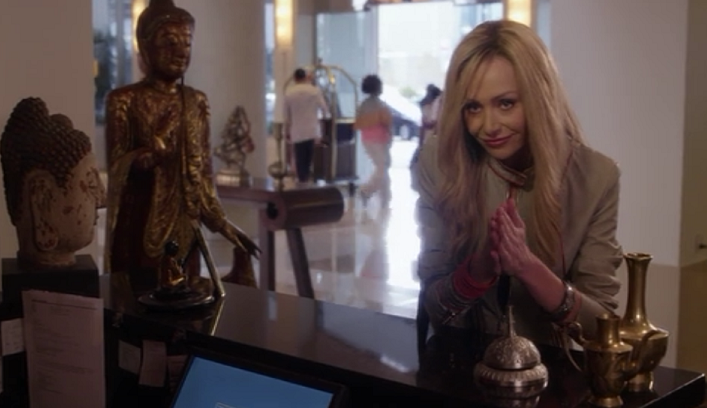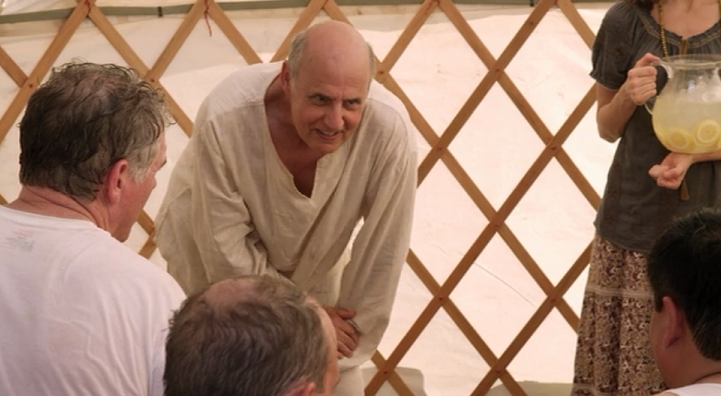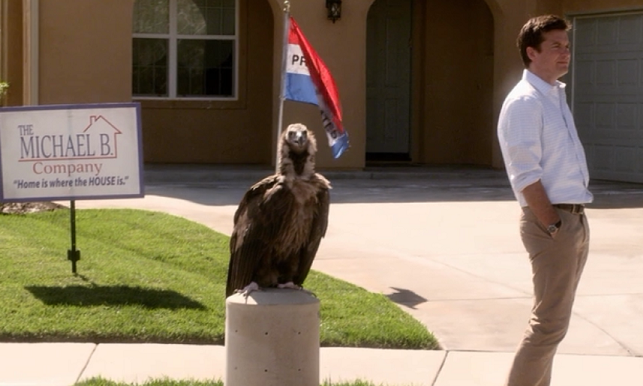It might have taken four seasons to get us there, but “The B. Team” at long last makes good on Michael’s life-long dream to get into the motion picture industry.
No, wait, let me rephrase that: For no reason whatsoever, we get an episode that crams Michael into the motion picture industry.
There’s a lot that’s strange about this episode, but perhaps the most glaring is that if Arrested Development wanted to make jokes about Imagine Entertainment and Jerry Bruckheimer, they already had someone working in the business: Maeby. For no particular narrative reason that I can fathom, this episode fires her and subs Michael in instead.
This is disappointing in a few ways, one of which is that Maeby’s entire character arc gets derailed abruptly, and another is that this probably would have been much funnier if it had been Maeby helming the project rather than Ron Howard (season three ended with her working on this exact project anyway) and Michael taking his role in the process much too seriously.
He still could have been tasked with collecting signatures, he still could bump into Rebel Alley, and he still could assemble his team and give the “already built” speech. A silly story could have flowed naturally from everything we’ve already seen, and give another family member something to do. Instead, we take a moment to dismantle everything so we can start fresh with the silliness, and that feels like a big step backward.
I mentioned earlier that I avoided spoilers while watching these episodes. I finished the season a few days ago, however, and I can say this conclusively: it’s impossible to spoil anything, because nothing actually happens.
Oh, sure, you could spoil a joke here or there. Or you can reveal the identity of someone off camera. But as far as narrative: there isn’t one. We’ll get into this much more in later reviews, but it applies here too; for all the hubbub and importance surrounding narrative developments this season, none of them actually go anywhere.
Which is why, I guess, we have an episode about Michael Bluth assembling a team…which does nothing and not one member of which we’ll see again. It’s probably also why Michael gets a job (which with uncharacteristic and evasive vagueness is never revealed) with Google, so he can drive a funny car and the narrator can make jokes about how they can’t mention the name Google. It’s all very funny if you’ve never seen Arrested Development before this season and therefore have no idea how much better these concepts can be handled.
This season is playing out like an imitator of itself. It’s like seeing one of those trailers for an indie film made by somebody who knows Wes Anderson is popular but doesn’t seem to know why, so he ends up packing his film with the funny costumes and the deadpan delivery and the quirky soundtrack but never quite gets around to writing a good script, piecing together a memorable story or understanding the artistry behind why a great filmmaker makes those decisions in the first place.
The difference is that Arrested Development is still made by the same people, which is what’s confusing. It’s almost like Hurwitz and crew turned to the first three seasons for inspiration, but just latched onto the superficial things (left-field sight gags, jokey narration, guest stars) and never managed to get at anything that made their own show great.
That’s about 700 words of one thing before I get around to revealing another, though: I kind of like “The B. Team.” In fact, this is the last episode through which I was able to retain the illusion that season four might have promise. It was all down hill from here.
It’s not a great episode of television, or even a good one. As I mentioned, none of this goes anywhere. Not within the context of the episode, and at no time later. It upends one character’s arc so another can take her place, when it really would have been smoother and more logical to keep her there. And, strangest of all, the story doesn’t spring forth from anything we know about Michael at all.
Taken in conjunction with “Flight of the Phoenix,” this latter point is especially glaring. That episode was about both his relationship with his son and his failure with Sudden Valley…two very important things to Michael, and the two areas in which failure would feel most cutting to him. In short, it allows him to be a character.
Then we got George Sr., whose episode was about his relationship with Oscar, a scam business, and defrauding the U.S. Government. Again, very George Sr.
Lindsay’s episode was a mess, but then again so was her plastic surgery. Oops! I mean, so was her character. She’s flightly and impulsive, and even if the episode was a trainwreck it was at least true to aspects of her character.
Now Michael is a film producer. And soon Tobias will create a musical about The Fantastic Four. And Lucille will guest star with some shrill Asian women on a reality show. Arrested Development season four will remind us over and over again that any handle it initially seemed to have on its characters was purely coincidental.
So why do I like “The B. Team?” Because it at least has some good gags, and if you forget (or don’t know) that none of this goes anywhere and we might as well watch Michael on a treadmill for 30 minutes, it at least feels like it’s giving the season some direction.
But most of all, here’s what I like: Kitty Sanchez. Carl Weathers. Warden Gentles. Andy Richter. In one fell swoop the show brings back characters that are characters, and it’s such a refreshing taste after China Garden and Marky Bark. Perhaps — it even seems to suggest — those boobish cartoons can one day be remembered as fondly as these old hands. You know that smile you got on your face when Carl Weathers helped himself to a Grinch doll? Maybe one day you’ll be just as happy to see your old pal China Garden!
Yeah, not likely. The reason it’s so nice to see these characters again isn’t just because they were great enough characters that we missed them, but because it means there isn’t any room for the lesser creations of season four to intrude on our fun.
We do get to meet one other new face, though: Rebel Alley. It’s not glaring here in her first appearance, but with the benefit of hindsight I can say I’m disappointed that she also doesn’t have much character. Compared to past season-long romances like Marta or Rita, there’s nothing going on with this character, and no particular reason that Michael would fall for her particularly, any more than he’d fall for any attractive woman.
Sure, he says she reminds him of his dead wife (real artful way of bringing that back, too) but that’s never been why Michael’s chased girls in the past. I would have preferred there to be something more to it than the fact that Michael gets a boner when he sees redheads.
Oh well. It may not get us anywhere, but Warden Gentles failing to get the hang of his iPad is worth the half hour in itself. It’s a little frustrating that the most serialized season of the show refuses to actually go anywhere, but as long as we can keep having fun along the way, I’m happy.
Spoiler: We don’t keep having fun along the way.
Episode 4: “The B. Team”
Central Character: Michael
Other Family Appearances: Maeby, George Sr., Tobias
Most Clumsy Reference to Original Run: “She’s British so she doesn’t seem…nobody can ever tell that she’s disabled.”
Scene That Most Needed Tightening: Pretty much any exchange with Ron Howard could do to be tightened up.
Best Line / Exchange:
ANDY: Help me remember. What did we do together?
MICHAEL: You came over for a chicken and hamwater dinner that my family threw to raise some funds for itself.
ANDY: And they’re finally getting around to making a movie about that, huh?
